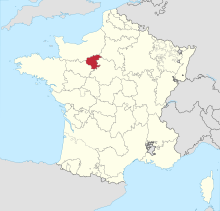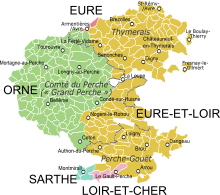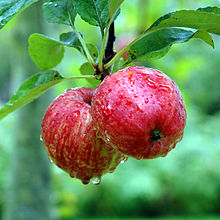Perche



Perche(French pronunciation:[pɛʁʃ]) (French:le Perche) is a formerprovinceof France, known historically for its forests and, for the past two centuries, for thePercherondraft horse breed.Until theFrench Revolution,Perche was bounded by four ancient territories of northwestern France: the provinces ofMaine,Normandy,andOrléanais,and the region ofBeauce.[a]Afterwards it was absorbed into the present-daydepartmentsofOrneandEure-et-Loir,with small parts in the neighboring departments ofEure,Loir-et-Cher,andSarthe.[2]
Toponymy
[edit]Percheis known by the following ancient Latin and French toponymic designations:saltus Particus,silva Perticusbefore the 6th century,pagus quem Pert[ic]ensem vocantandpagus pertensisin the 6th century,pagus Perticusno date andc. 815,Particus saltusin the 11th century,silva Perticusin 1045,[le] Perchein 1160–1174 and in 1308,Perchein1238,foresta de Perticoin1246,[3][4]where the names starting byPertorPartdenotePerche,[b]the termssilvaandforestamean forest,[c]Saltusdesignates a wooded mountainous region, frontier, wildlife refuge,[d][e]pagusmeans country, andsilva perticarefers to a tall-treed forest.[f]
An hypothesis put forth by the linguist Guy Villette based on the namePerchehaving initially designated the forest region, and not the province, would havePercherepresent the pre-Celtic name of indo-european origin *perkʷ-ik-ā« (forest) with long trees », dissimilated into *pertika, and transmitted as such in the Gallic language, even though the initialp-was foreign to this language.[5]The indo-european radical *perkʷu-,"large tree: oak, pine, fir, beech..." is also the origin of the Latin wordquercus« oak » and the common Germanic word *furhu-,source of the English and German wordsfirandFöhre« pine ».[5]
Until about the 11th or 12th century, such terms aspagus Perticusorpagus Pertecensisused in connection with Perche's ancient forest are accordingly understood to refer to a frontier region without precise geographical limits and thus not to a clearly defined political or administrative territory.[6]
Geography
[edit]
Before theFrench Revolution,Perche was bounded by the following ancient provinces:Normandyto the north and west, Maine to the west,Beauceto the east andOrléanaisto the south.
Perche is dominated by four topographical-featured arcs:[7]
- An outer arc marked by the high edge of a flat high plateau to the west and south of the Perche's eastern and northern limits
- An inner arc, concentric to the high plateau edge arc, defined by theHuisne River,a tributary of theSarthe River,situated in Perche's irregular lowlands.
- Forest arcs inles collines du Perche(the Perche hills) on either side of the Huisne, consisting of a main forest arc off the Huisne's left bank stretching fromMoulins-la-MarchetoMontmirailand a secondary forest arc off the Huisne's right bank fromPervenchèrestoLe Thiel.
Within the Huisne watershed lie the three unofficial Perche capitals:Nogent-le-Rotrou(economic capital),Mortagne-au-Perche[8](administrative capital) andBellême[9](historical capital).[10]
The Perche hills[g]are the source of numerous small tributaries of theSeine Riverwatershed via theEure,Avre,Iton andRislerivers and theLoire Riverwatershed via theHuisne,LoirandSartherivers.
Perche's principal towns
[edit]
The following table lists the principal towns in Perche province along with the distance of any given town to Condé-sur-Huisne, situated near Perche's geographic center:
| km | km | km | km | km | |||||
| Arrou | 48 | Ceton | 23 | La Ferté-Vidame | 29 | Luigny | 31 | Senonches | 29 |
| Authon-du-Perche | 29 | Chateauneuf-en-Thymerais | 40 | La Loupe | 18 | Montmirail | 41 | Thiron-Gardais | 15 |
| Bellême | 27 | Condé-sur-Huisne | ~0 | Le Gault-du-Perche | 43 | Mortagne-au-Perche | 31 | Tourouvre | 44 |
| Brezolles | 45 | Digny | 32 | Longny-au-Perche | 22 | Nogent-le-Rotrou | 8 | Verneuil-sur-Avre |
Peripheral towns
[edit]
Nearby towns in the four ancient provinces along the periphery of Perche province include (starting from the north, clockwise):L'Aigle,Dreux,Chartres,Châteaudun,Le Mans,Mamers,AlençonandSées.
Economy
[edit]
Agriculture and tourism constitute the economic focus of Perche's natural region, the largest parts of which are located within the departments ofOrneandEure-et-Loir,in the regions of Normandy andCentre-Val de Loire,respectively.
ThePercheronbreed ofdraft horsesoriginated in Perche'sHuisneriver valley and is identified throughout the world as the Perche's most well known symbol. Apples (forhard cider) and pears are grown throughout the Perche territory.

History
[edit]
Prehistory
[edit]Perche's prehistory is manifested bymegaliths(dolmens,menhirs) and prehistoric tools of flint, bronze, and iron.[11]
Middle Ages
[edit]Perche was essentially a region between other regions:
"...the Perche was not based on an existing administratative unit, such as its neighbors, the counties of Maine andChartres,nor was it coterminous with an ecclesiastical jurisdiction. It grew up at the margins of several larger units, and there was no major population focus nor great religious centre such as a cathedral or ancient abbey within it. It owed its existence to the ambition and energy of successive members of a lineage of warrior elite. "[2]
The Romans found possession of the Perche forests was necessary for the conquest of the vastArmoriqueand Normandy territories extending from theLoireestuary off the Atlantic coast toDieppeoff theEnglish Channel.[12]
Until the Viking or Norman invasions in the 9th century, Perche was a relatively remote area bounded on all sides by the followingGaul-Romanterritories andCelticpeoples: to the east and south theCarnutespeople in Chartrain territory based inChartres;to the northeast theAulerques Eburoviquespeople in Évreux territory based inÉvreux;to the southwest theAulerques Cénomanspeople in Maine territory based inLe Mans;and to the northwest the Hyesmois (Essuins) people in Exmes territory based inSéez.[13]These territories eventually became first Romancivitates,to then become the dioceses ofChartres,Evreux,Le MansandSéez.that did not change significantly in terms of geographical limits until the Revolution.[14][15][16]Thus Perche has traditionally been shared between three of these four dioceses as follows:[17]
- Parishes in northwest Perche such as in the town of Mortagne have been part of Séez diocese;
- Parishes in eastern Perche such as in the towns of Tourouvre and Nogent-le-Rotrou have been part of Chartres diocese;
- Parishes in southwest Perche such as in the town of Bellême have been part of Le Mans diocese.
- The Commune of Thiron-Gardais was occupied by the mother abbey of theTironensian Orderof monks who founded the order in 1106.
In theMiddle Ages,the County of Perche was controlled by an independent line of counts. By the 12th century, two large families contended for control of the Perche region: the Talvas ofBellême familyand theRotrou familyof Nogent-le-Rotrou. In 1114, Rotrou III annexed Bellême. In 1226,Count Geoffroy Vwould have been a leader of theFourth Crusadehad he not died before its departure to the Near East. This end of the Rotrou dynasty led to the region's annexation to theCrown of France(by inheritance). At this time, the crown divided part of the region to create the county ofAlençon.After 1325, both counties were generally held by a member or members of acadet branchof theHouse of Valois.During theHundred Years War,partisans of England plundered Perche, destroyed its nobility, and burned many castles and abbeys. In 1449, free from English domination, Perche began reconstruction. Upon the death of Alençon's last duke (1525), rule returned to and remained under the French crown, and was granted only sporadically thereafter.[2][11][12]
Modern times
[edit]
In the three decades starting in 1632, a large proportion of immigrants toNew Francecame from Perche, in what has been called the Percheron immigration movement.[18]Many Percherons were thus recruited to work inseigneuriesbeing establishing along theSaint Lawrencevalley. TheBeauportseigneurie, New France's first agricultural-oriented seigneurie, was granted in 1634 toRobert Giffard de Moncelby theCompany of Hundred Associates.While the total number of emigrants was small, Perche had a much higher rate of emigration to New France than most other regions of France. Nearly allFrench Canadianshave some ancestors from the villages of Perche.[11]Prominent last names from Perche who came to Canada starting just before the end ofSamuel de Champlain's tenure include: Côté, Boucher,Cloutier,Guyon (Dion),Tremblay andParadis.[19]
After the French Revolution, Perche was divided into four departments: Orne, Eure-et-Loir, Sarthe, and Loir-et-Cher. At this time, national law replacedFR:coûtume du Percheor local, customary law.[11]
In 1998, the government of France created the Perche Regional Nature Park (Parc naturel régional du Perche– seeFR:Perche (région naturelle)).[20]The park is forested mostly by beech, birch, chestnut, oak (especially sessile and pedunculate species), as well as conifers (especially Douglas fir and pine species)[21]populated by wildlife including boar, buzzard, deer, squirrel, woodcock and woodpecker species.[22][23]
Notes
[edit]- ^Orléanais and Beauce were collectively known asPays Chartrain
- ^AccordingAuguste Longnon1878: Le nom latin du Perche estPerticus.Auguste Longnon (1878).Géographie de la Gaule au VIesiècle,Paris (corrected to Pert[ic]ensis). p. 155
- ^According to René Musset: "Le Perche est mentionné pour la première fois au VIesiècle, parGrégoise de Tours,sous le non depagus pertensis(pert[ic]ensis); à partir de ce moment, il est souvent question dans les textes du Perche, appelé tantôtpagus perticus,tantôtsilva pertica.Il semble bien, sans qu’on puisse l’affirmer avec une entière certitude, que le mot de Perche soit étymologiquement un vieux nom de forêt. Il est hors de tout doute que l’expression depagus perticusdésigne une région naturelle, non une circonscription administrative: le Perche ne deviendra tel que dans la seconde moitié du XIesiècle. Le Perche est donc un pays, et ce pays est unesilva,une forêt. "René Musset (1919)"Le Perche - Nom de pays".Annales de géographie.p. 351
- ^According toCentre Généalogique de l'Orne et du Perche - De la préhistoire aux invasions Normandesciting Dict. latin-français de Riemann et Goelzer: « Le sens précis de saltus est "région montueuse et boisée... retraite de bêtes fauves" »
- ^According to Sarah Fourcade citingPierre ToubertinFrontière et frontières: un objet historique,p. 14: «... la frontière constitue une zone de développement. Certes, avant d’être mise en valeur et de devenir rentable, la frontière n’est qu’un ‘’saltus’’, une zone où peut s’observer « le phénomène inverse de désertification frontière », avec cette image tenace jusqu'au XIesiècle... », Sarah Fourcade (2018)."Frontière et marche, société et noblesse de frontière en péninsule Ibérique"
- ^According to Ville de Québec, toponymie, Perche: "Au Moyen Âge, la forêt recouvre presque entièrement le territoire du Perche, comme le dénote son nom originel: Sylva pertica, du latin pertica, « perche » ou « grand arbre »."
- ^Collines du Perche
References
[edit]- ^Hommey, L. (1899).Histoire générale, ecclésiastique et civile, du diocèse de Séez ancien et...p. 282.
- ^abcThompson, Kathleen (2002).Power and Border Lordship in Medieval France: The County of the Perche, 1000-1226.Boydell & Brewer. pp. 5, 9 ( "the Perche" and modern equivalent), 11 (margins, formation), 13.ISBN9780861932542.Retrieved21 March2018.
- ^Nègre, Ernest (1990).Toponymie générale de la France,Volume I, Librairie Droz. p. 398
- ^Dominique Fournier, "Notes de toponymie normande: Promenons-nous dans les bois… (au sujet de quelques noms de bois et de forêts en Normandie)" inHistoire et Traditions PopulairesNo. 136 (mars 2017), p. 17-32
- ^abVillette, abbé Guy (1988 / 1994). « Le nom du Perche » inNoms de lieux — Noms de vie,Actes du 2e colloque de la Lubinière, mai 1988,Cahiers percherons,1994, n° 2-3, pp. 7-21 (see especially pp. 14-15)
- ^Viscomte de Romanet (1903).Géographie du Perche et chronologie de ses comtés...p. 26
- ^René Musset (1920).Le relief du Perche,p. 99
- ^"L'organisation hydrographique du Parc".Parc naturel du Perche.
Réseau hydrographique, Nom du cours d'eau - la Chippe [Mortagne-au-Perche is located at the source of this tributary of the Huisne River]
- ^"L'organisation hydrographique du Parc".Parc naturel du Perche.
Réseau hydrographique, Nom du cours d'eau - la Même [Bellême is located at the source of this tributary of the Huisne River]
- ^Orne évasions
- ^abcd"Un peu d'Histoire".Fédération des Amis du Perche.Retrieved18 March2018.
- ^ab"Trizay - Le Perche: Ses origines et la formation du Comté du Perche".Retrieved13 April2019.
- ^Fret, Joseph (1838).Antiquités et chroniques percheronnes ou recherches sur l'histoire civile... v. 1,pp. 1-2
- ^Bourdin, Foubert & Foucher (2012),‘'L'Orne, des térritoires, une histoire’'Archived2016-03-03 at theWayback Machine,pp. 34-35
- ^Wikipedia Map of Dioceses of metropolitan France
- ^Vicomte de Romanet (1903).Géographie du Perche et chronologie de ses comtés...citing in pp. 15-16 M. L. Duval'sEssai sur la toponymie ancienne du département de l'Orne(1882).
- ^Viscomte de Romanet (1903).Géographie du Perche et chronologie de ses comtés...pp. 15-21: Evreux diocese is associated with parishes to the northeast of Perche that are not however within limits of Perche proper.
- ^perche-canada.net."Association Perche-Canada History".
- ^ Larson, Denise R. (2008).Companions of Champlain: Founding Families of Quebec, 1608-1635.Genealogical Publishing.ISBN9780806353678.Retrieved21 March2018.
- ^"A natural park for the Perche".Parc naturel régional du Perche. 23 November 2015.Retrieved21 March2018.
- ^Inventaire Forestier National (2010).La forêt française - Les résultats pour la région Basse-Normandie(PDF).p. 9.ISBN978-2-11-128059-5.RetrievedMarch 9,2019.
- ^"Profil environnemental de Basse-Normandie"(PDF).2015. pp. 42, 86.RetrievedMarch 9,2019.
- ^"The true nature of Perche".Parc naturel régional du Perche. 23 November 2015.Retrieved21 March2018.
See also
[edit]External links
[edit]- Association Perche-Canada
- Centre Généalogique de l'Orne et du Perche
- Parc naturel régional du Perche
- perche-quebec.com
- Rossant, Colette(25 March 2007)."France's Le Perche Is the Last Terroir".New York Times.Retrieved21 March2018.</ref>
- Vermont French-Canadian Genealogical Society:Le Perche
- Perche
- Former provinces of France
- Geography of Eure
- Geography of Eure-et-Loir
- Geography of Loir-et-Cher
- Geography of Orne
- Geography of Sarthe
- History of Normandy
- History of Centre-Val de Loire
- History of Pays de la Loire
- History of Eure
- History of Eure-et-Loir
- History of Loir-et-Cher
- History of Orne
- History of Sarthe

